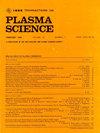LWFA中注入电子的电子丝结构
IF 1.3
4区 物理与天体物理
Q3 PHYSICS, FLUIDS & PLASMAS
引用次数: 0
摘要
在激光脉冲前没有等离子体密度上升的情况下,使用二维粒子池(PIC)模拟,我们观察到在激光尾流场加速(LWFA)的气泡状态下自注入过程中,线状细长电子结构(称为电子丝)的形成。在相对较低的等离子体密度下,大约$ {\mathrm {e18~\text {c}\text {m}}}{-3}$,当一个大气泡从后面关闭其后缘时,自注入的电子继续在气泡内沿不同的轨迹移动,产生明确的电子丝,从气泡内部测量的角度大于180°。当等离子体密度高于2.5 × 1018 cm−3时,气泡在其后部关闭,边缘的夹角小于180°,从而导致不同的注入动力学。我们使用哈密顿力学来研究这些轨迹,以及它们如何影响这些情况下的电子加速器振荡。结果表明,等离子体密度越高,由于气泡中的加速场越强,电子加速到更高的能量,从而产生更高的洛伦兹因子,从而导致电子振荡幅度越小,振荡强度参数越大。我们还表明,通过在光束入口引入线性密度上升,气泡的几何形状被修改,从而影响电子加速器的振荡,并可能调整加速过程。本文章由计算机程序翻译,如有差异,请以英文原文为准。
Electron Filament Structures of Injected Electrons in LWFA
We observe the formation of thread-like elongated electron structures, referred to as electron filaments, during the self-injection in the bubble regime of laser wakefield acceleration (LWFA) using 2-D particle in cell (PIC) simulations, for no plasma density upramp preceding the laser pulse. At relatively low plasma densities, around $ {\mathrm {e18~\text {c}\text {m} }}^{-3}$ , the self-injected electrons continue to move on separate trajectories inside the bubble creating well-defined electron filaments when a large bubble closes its rear edges from behind, making an angle larger than 180° measured from the interior of the bubble. At higher plasma densities, above 2.5 × 1018 cm−3, the bubble closes at its rear with the edges making a smaller angle than 180°, resulting in a different injection dynamics. We examine these trajectories using Hamiltonian mechanics and how they impact the betatron oscillations in these cases. The results indicate that higher plasma densities result in smaller betatron oscillation amplitudes and larger wiggler strength parameter due to the stronger accelerating fields in the bubble, which accelerate the electrons to higher energies, giving higher Lorentz factors. We also show that by introducing a linear density upramp at the beam entrance, the bubble’s geometry is modified, thereby influencing the betatron oscillations and potentially tuning the acceleration process.
求助全文
通过发布文献求助,成功后即可免费获取论文全文。
去求助
来源期刊

IEEE Transactions on Plasma Science
物理-物理:流体与等离子体
CiteScore
3.00
自引率
20.00%
发文量
538
审稿时长
3.8 months
期刊介绍:
The scope covers all aspects of the theory and application of plasma science. It includes the following areas: magnetohydrodynamics; thermionics and plasma diodes; basic plasma phenomena; gaseous electronics; microwave/plasma interaction; electron, ion, and plasma sources; space plasmas; intense electron and ion beams; laser-plasma interactions; plasma diagnostics; plasma chemistry and processing; solid-state plasmas; plasma heating; plasma for controlled fusion research; high energy density plasmas; industrial/commercial applications of plasma physics; plasma waves and instabilities; and high power microwave and submillimeter wave generation.
 求助内容:
求助内容: 应助结果提醒方式:
应助结果提醒方式:


